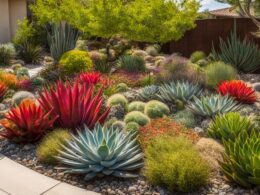Creating an efficient and water-wise landscape is the goal of xeriscape landscaping. And at the heart of a successful water-wise landscape lies the health and maintenance of the soil. In low desert areas, you often encounter heavy clay soils and sandy soils with caliche layers. These soils can become compacted, slow to absorb water, and prone to runoff. Additionally, desert soils tend to be alkaline. However, many desert plants thrive naturally in these conditions. To ensure the health of your xeriscape landscape, additional soil amendments and improvements may be necessary for turf areas, flower or vegetable gardens, and non-native plants. By understanding the types of soil, implementing soil improvements, and practicing proper maintenance, you can create a thriving xeriscape garden that conserves water and sustains itself with minimal effort.
Key Takeaways:
- Xeriscape landscaping aims to create efficient and water-wise landscapes.
- Understanding the different soil types and their characteristics is crucial in xeriscaping.
- Proper soil preparation is essential for water conservation in xeriscape landscapes.
- Efficient watering practices and proper irrigation systems play a significant role in water conservation.
- Maintaining a xeriscape landscape involves proper maintenance tasks such as watering, soil preparation, fertilizing, weed control, pruning, and mowing.
Types of Soil and Soil Improvement in Xeriscaping
In xeriscaping, understanding the different types of soil and how to improve them is essential for creating a successful water-wise landscape. In low desert areas, two common soil types are clay soils and sandy soils with caliche layers. Clay soils are heavy and easily compacted, while sandy soils drain well but may have caliche layers that prevent proper water drainage.
To improve soil health in xeriscape landscapes, there are several key strategies you can implement. The first step is to loosen the soil at planting time to encourage better water infiltration. This can be done by tilling or using a garden fork to break up compacted soil. Another effective method is the use of organic mulches, which improve conditions for soil microbes and help retain moisture. Additionally, consider regrading your yard to collect rainwater instead of allowing it to drain away, promoting water conservation within your landscape.
Soil Amendments
To further enhance the health of your soil, incorporating soil amendments is crucial. Compost and organic matter are excellent additions to turf areas, flower or vegetable gardens, and non-native plants in desert landscapes. These amendments improve soil structure, moisture retention, and nutrient availability for plants. By adding compost or well-rotted manure annually to your garden areas, you can promote healthier soil and provide a better environment for your plants to thrive.
- Loosen the soil at planting time to encourage better water infiltration.
- Use organic mulches to improve conditions for soil microbes and retain moisture.
- Consider regrading your yard to collect rainwater instead of allowing it to drain away.
- Incorporate soil amendments like compost or well-rotted manure to improve soil structure and nutrient availability.
By implementing these soil improvement tips, you can create a more favorable environment for your xeriscape plants to grow and thrive. Healthy soil not only conserves water but also provides the necessary nutrients and support for your plants to flourish in a water-wise landscape.
Essential Factors in Xeriscape Soil Preparation
Proper soil preparation is key to successful water conservation in xeriscape landscapes. Whether dealing with sandy soils or clay soils, there are specific challenges that need to be addressed to create a healthy and water-efficient garden.
Challenges of Sandy Soils
Sandy soils have larger particles and tend to drain water rapidly, which can lead to water loss and the inability of plants to absorb moisture effectively. To tackle this challenge, it is essential to add organic matter to sandy soils. This helps improve water retention, enriches the soil with nutrients, and promotes the growth of beneficial microbes. Organic matter, such as compost or well-rotted manure, can be incorporated into the soil annually to enhance its structure and moisture-holding capacity.
Challenges of Clay Soils
On the other hand, clay soils have smaller particles and can become compacted, making it difficult for water to penetrate the surface. This often leads to runoff and water waste. To overcome this challenge, it is crucial to improve the drainage and aeration of clay soils. Adding organic matter, such as compost or well-rotted manure, can help break up the compacted soil, allowing for better water infiltration. Additionally, amending clay soils with sand or perlite can further enhance drainage capabilities.
Adding Organic Matter
Regardless of the soil type, adding organic matter is a fundamental step in xeriscape soil preparation. It improves soil structure, increases water-holding capacity, and enhances nutrient availability for plants. Consider incorporating compost, well-rotted manure, or other organic materials into the soil prior to planting. This will create a healthier soil environment that supports the growth of drought-tolerant plants and minimizes water requirements.
How Does Fertilizing Impact Xeriscape Soil Health and Maintenance?
When it comes to maintaining a healthy xeriscape, fertilizing xeriscape properly can have a significant impact on the overall soil health and maintenance. By using the right fertilizers in the correct amounts and at the appropriate times, you can help support the growth of drought-tolerant plants while minimizing water usage and maintenance needs.
Watering and Irrigation Practices in Xeriscape Landscapes
Efficient watering practices are essential for maintaining a thriving xeriscape landscape while conserving water. By following proper irrigation techniques, you can promote healthy plant growth and minimize water waste.
Deep and Infrequent Watering
One of the key principles of efficient watering in xeriscaping is to water deeply and infrequently. This encourages deeper root growth, making plants more resilient to drought conditions. Instead of shallow, frequent watering, allow the soil to dry out between watering sessions.
Take the time to observe your plants and check the moisture levels in the soil. Use a moisture meter or simply feel the soil with your hands. Watering should be done when the top few inches of soil are dry.
Tip: To ensure deep watering, water slowly and evenly to allow the water to penetrate the soil without causing runoff. Using a drip irrigation system or soaker hoses can be particularly effective in delivering water directly to the plant roots.
Irrigation System Maintenance
Regular maintenance of your irrigation system is crucial to ensure its efficiency and prevent water waste. Here are some important maintenance practices:
- Check for leaks or damaged sprinkler heads and promptly repair or replace them.
- Adjust sprinklers to ensure proper coverage and avoid watering non-landscaped areas.
- Clear any obstructions, such as vegetation or debris, that may interfere with the water distribution.
- Regularly inspect and clean filters to prevent clogging and maximize water flow.
Performing a periodic audit of your irrigation system can help identify any inefficiencies and make necessary adjustments for optimal water usage.
Proper Irrigation Practices
In addition to deep and infrequent watering, there are several other practices that can contribute to efficient water use in xeriscape landscapes:
- Identify areas that receive unnecessary water, such as sidewalks or driveways, and adjust sprinklers to avoid overspray.
- Avoid overwatering trees and shrubs by adjusting irrigation schedules based on their water requirements.
- Apply water more slowly to slopes to prevent runoff and ensure proper absorption.
Mulching the landscape with organic materials, such as wood chips or bark, can help retain soil moisture and reduce evaporation. Choosing drought-resistant plants that are well-suited to your climate and soil conditions further enhances water conservation in your xeriscape garden.
Conclusion
Maintaining a xeriscape landscape involves implementing a few key practices to ensure its longevity and efficiency. By following these xeriscape maintenance tips, you can create a low-maintenance landscape that conserves water and requires minimal upkeep.
Efficient Watering
One of the most important aspects of xeriscape maintenance is efficient watering. Implement deep and infrequent watering practices to encourage deeper root growth and reduce the overall water demand. By watering deeply and less frequently, you can save water while promoting healthy plant growth.
Choosing Low-Maintenance Landscapes
Avoiding high-maintenance plants and opting for native or drought-resistant varieties can significantly reduce the amount of time and effort required for maintenance. These low-maintenance landscapes are well-adapted to local conditions, requiring less water, fertilizer, and overall care.
Implementing Water-Wise Practices
By incorporating water-wise practices in your xeriscape maintenance routine, you can further conserve water and enhance the sustainability of your landscape. This includes the use of organic mulches to retain moisture, avoiding over-fertilizing to prevent excessive growth, and regularly weeding, pruning, and mowing to keep your landscape looking its best.
By implementing these xeriscape maintenance tips and embracing water-wise practices, you can create a thriving and sustainable xeriscape garden. Not only will you conserve water, but you will also enjoy a low-maintenance landscape that flourishes with minimal effort.












